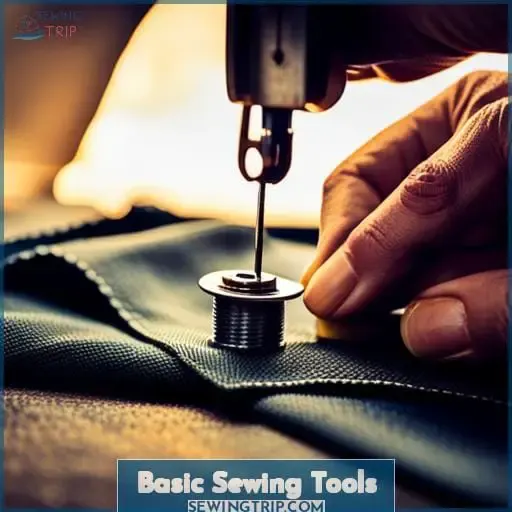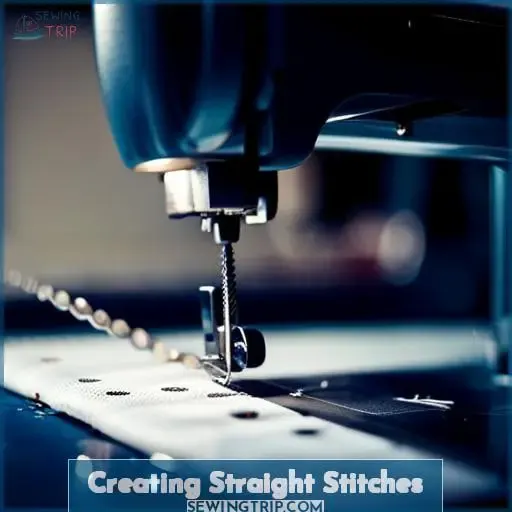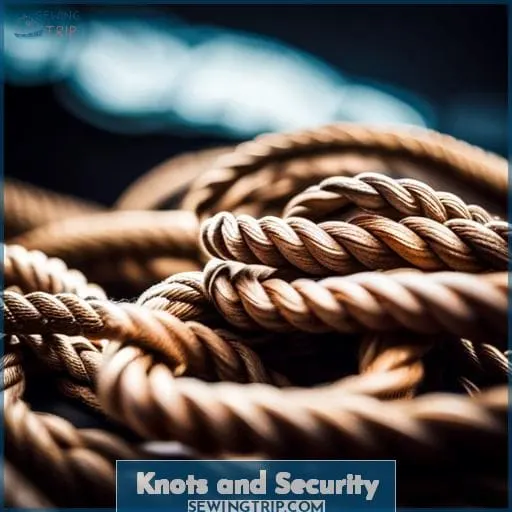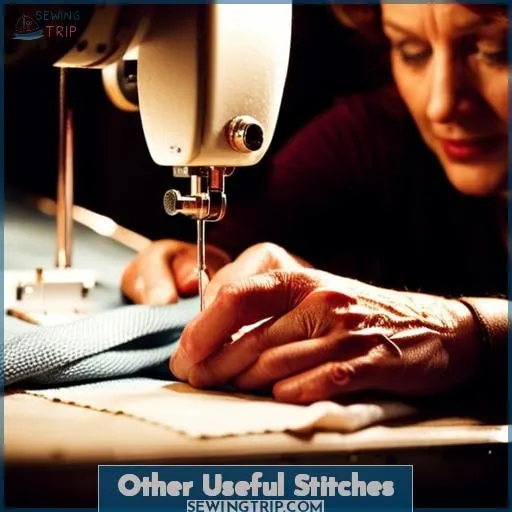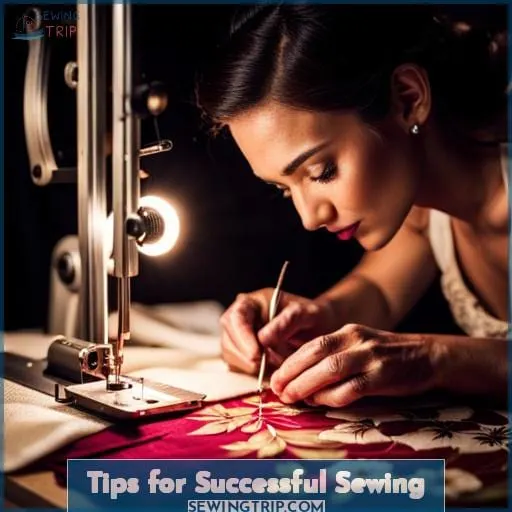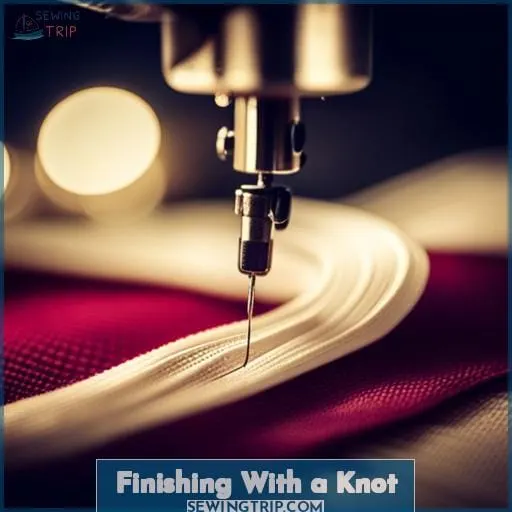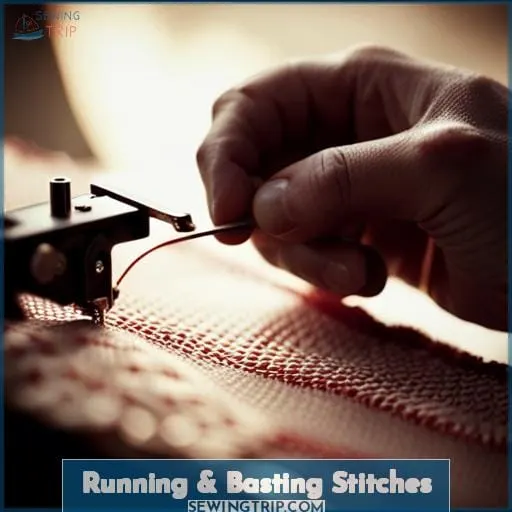This site is supported by our readers. We may earn a commission, at no cost to you, if you purchase through links.
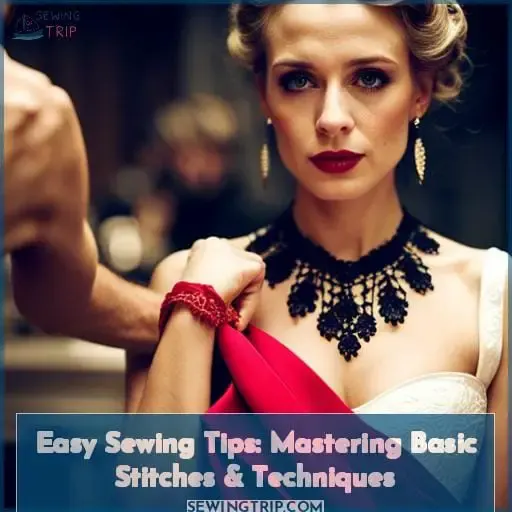 Get ready to master the art of sewing with these easy tips and techniques!
Get ready to master the art of sewing with these easy tips and techniques!
You’ll learn how to:
- Create straight stitches
- Tie secure knots
- Use other useful stitches for successful sewing
Plus, we’ll share helpful tips along the way so you can become a confident seamstress in no time.
Whether you’re a beginner or just looking to enhance your skills, this article will guide you through mastering basic stitches with ease.
Let’s get started on your journey to becoming an expert sewer!
Table Of Contents
Key Takeaways
- Use the proper tools and equipment for sewing.
- Pay attention to stitch length and fabric selection.
- Learn different knot techniques for secure stitching.
- Explore various stitches for versatility and decorative purposes.
Basic Sewing Tools
To begin your sewing journey, start by gathering all the necessary tools for this craft.
Sewing essentials include:
- Needles
- Scissors
- A pincushion with pins
- Measuring tape
- Marking pens
Needles come in different types for various sewing techniques and fabrics. Make sure to select the right needle based on your project’s requirements.
Scissors are essential for cutting fabric accurately; dressmaking shears are ideal for this task.
A pincushion helps keep your pins organized and within reach while you sew.
Measuring tape ensures precise measurements when working with fabric and patterns.
Marking pens are useful for embroidery or pattern marking on fabric surfaces.
Remember that having these basic sewing tools will make it easier to master essential techniques and create beautiful garments or crafts!
Creating Straight Stitches
Start by poking the needle into the far edge of your fabric piece or pattern template before beginning each new row or segment when creating straight stitches.
The key elements involved include considerations like adjusting:
- Stitch length – keeping consistent distance between each individual stitched point;
- Needle placement – ensuring accuracy on both sides so neither side appears loose nor too tight;
- Thread tension – achieving an optimal balance allowing smooth movement without puckering while maintaining proper hold;
- Fabric choice- selecting appropriate materials based on their texture, thickness, weight, stretchiness, durability, etc.;
- Straight-stitch variations offer flexibility options such as running/ gathering/basting/backstitches among others which allows users versatility during garment construction or alterations.
Making sure these aspects are addressed properly helps users master basic techniques ultimately empowering them towards liberation through self-expression, creativity, craftsmanship, even entrepreneurship through quality apparel production.
Knots and Security
Tie your thread securely by creating a knot to ensure the security of your hand-sewn stitches. Knots are essential for maintaining the strength and longevity of your sewing projects. There are various techniques for tying knots, allowing you to choose one that suits your needs.
To create a secure knot, start by poking the needle through the wrong side of the fabric, pulling it halfway through to form a loop. Then weave the needle up into this loop, creating a tight and secure knot. Repeat this process 2-3 times for added strength.
Remember that different fabrics may require different types of knots or additional securing techniques such as backstitching or slip stitching.
By mastering proper knotting techniques, you can ensure that every stitch is securely fastened and enjoy peace of mind knowing that your hand-sewn creations will withstand daily use with ease!
Other Useful Stitches
Now that you have mastered the basic stitches and learned how to create secure knots, it’s time to explore other useful stitches that will take your sewing skills to the next level. These advanced stitches not only add decorative flair but also provide endless possibilities for stitch variations and applications in your projects.
One of these useful stitches is the zig-zag stitch, which is perfect for elastic waistbands or securing edges. By creating diagonal points with each stitch, you can achieve a sturdy and visually appealing finish.
Another essential stitch is the slipstitch, ideal for binding two fabric pieces together seamlessly. This invisible stitching technique hides any visible seams while ensuring durability.
Don’t be afraid to experiment with different decorative techniques like blanket stitching or whipstitching as well. These visible seam stitches are great for joining fabric pieces or adding unique finishes to folded edges.
Remember these tips as you delve into advanced stitching:
- Practice patience when working on intricate designs.
- Choose appropriate thread thicknesses based on project requirements.
- Always test new techniques before applying them in your final piece.
With dedication and creativity in exploring various advanced stitches’ applications, you’ll soon become a master tailor/seamstress capable of tackling any sewing challenge!
Tips for Successful Sewing
To ensure successful sewing, it’s important to pre-wash your fabric before starting any projects.
Here are three tips for achieving great results in your sewing endeavors:
- Fabric Selection:
- Choose the right fabric for your project by considering its weight, stretch, and drape.
- Different fabrics require different techniques and stitches.
- Take time to practice stitching straight lines and maintaining consistent stitch lengths.
- This will improve the overall appearance of your finished piece.
- Select the appropriate needle type based on the thickness of your fabric and thread type you’re using.
- Additionally, remember to change needles regularly as dull or damaged needles can cause skipped stitches or snagging.
By following these tips for successful sewing, you’ll be well on your way to creating beautiful garments and crafts with confidence!
Finishing With a Knot
Securing your stitches is essential for a professional finish, ensuring longevity and strength in your sewing projects.
When it comes to finishing with a knot, there are different techniques you can use depending on what you’re trying to achieve.
Knot security is crucial for preventing unraveling and maintaining the integrity of your stitches.
To enhance knot security, consider thread waxing before tying the knot. This helps lubricate the thread fibers, making them less prone to slipping or coming undone over time.
Additionally, decorative techniques such as French knots or embroidery knots can add an extra touch of creativity to your projects while also securing your stitches effectively.
By mastering various types of knots and exploring decorative stitching methods, you’ll elevate the quality and aesthetic appeal of every sewing project.
Running & Basting Stitches
First, start by running your needle through the fabric to create a basic running stitch.
This stitch variation is essential in sewing as it can be used for various techniques and applications.
The running stitch involves making small stitches evenly spaced apart on both sides of the fabric.
It’s commonly used for basting, gathering fabric, or sewing seams that need to be easily removed later on.
When using this technique, it’s important to maintain consistency in the length and spacing of your stitches for a neat and professional finish.
Practice this stitching method during your sewing projects to improve your skills and achieve mastery over different sewing techniques.
Frequently Asked Questions (FAQs)
What are some common mistakes to avoid when creating straight stitches?
To create flawless straight stitches, avoid common mistakes:
- Inconsistent stitch distance
- Not turning the fabric over with each needle poke
Remember to secure your knots for added strength in your sewing projects.
How do I choose the right needle for my sewing project?
To choose the right needle, consider your sewing project’s needs.
Sharp needles suit basic stitches.
Betweens work for quilting.
Larger-eyed ones handle thicker threads.
Let your needle be a match made in stitching heaven!
Can you provide some tips for preventing fabric fraying while sewing?
To prevent fabric fraying while sewing, finish the raw edges by using techniques like:
- Zig-zag stitching
- Sergeing
- Applying fray check
- Using pinking shears to create small triangular cuts along the edge.
What are some alternative methods for securing fabric besides knots?
When it comes to securing fabric without knots, you can try using:
- Adhesive tapes
- Fusible webbing
- Fabric glue
These alternatives provide a strong hold and are great for projects that require a clean finish.
How can I improve my sewing technique to make my stitches more even and professional-looking?
Master the art of sewing by honing your technique.
Practice makes perfect, so don’t be afraid to sew with confidence.
With each stitch, you’ll gain power over fabric and create professional-looking masterpieces that will showcase your sewing prowess.
Conclusion
In summary, mastering basic stitches and techniques in sewing is easier than you think.
By learning how to create straight stitches, tie secure knots, and use other useful stitches, you’ll be well on your way to becoming an expert sewer.
With the help of some essential sewing tools and helpful tips, you’ll gain the confidence you need to tackle any sewing project.
So don’t wait any longer, start practicing these easy sewing techniques and soon you’ll be sewing like a pro.
Happy sewing!

